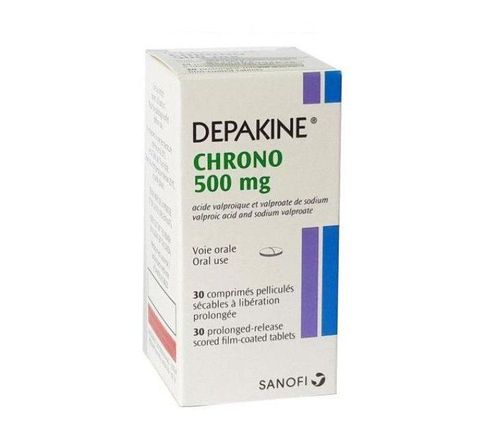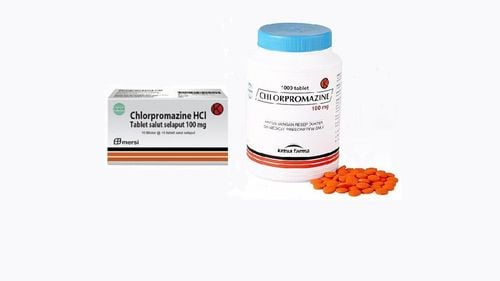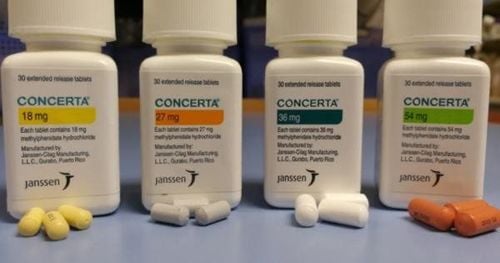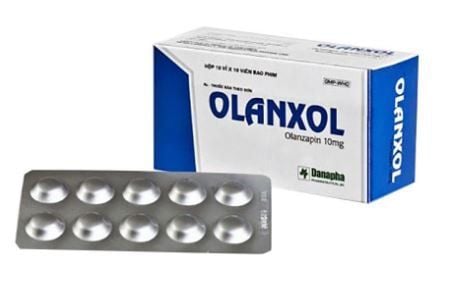This is an automatically translated article.
Zolafren is indicated in the treatment of patients with schizophrenia, bipolar disorder, or rapid cycling bipolar disease. To ensure the effectiveness of using Zolafren, users need to follow the instructions of their doctors and refer to the following article for more information about the uses of Zolafren.1. What are the effects of Zolafren?
1.1. What is Zolafren? Zolafren belongs to the group of sedatives, antipsychotics of the Benzodiazepine group. The drug has registration number VN-19299-15, manufactured by Pharmaceutical Works Adamed Pharma Joint Stock Company - Poland.
Zolafren has the main ingredient Olanzapine 5mg or 10mg. Excipients: lactose, lecithin... The drug is prepared in the form of 5mg tablets, packed in blisters of 14 tablets, each box of 2 blisters and 10mg blisters of 7 tablets, boxes of 4 blisters.
Zolafren is recommended for use by adults 18 years of age and older.
1.2. What are the uses of Zolafren? Olanzapine is an effective antipsychotic, anti-manic, and mood-stabilizing drug. The drug causes less extrapyramidal syndrome, less prolactin secretion, less late-stage dyskinesia with prolonged treatment and suppression of schizophrenia.
Zolafren is prescribed by a doctor in the following cases:
Patients with schizophrenia, bipolar disorder: Manic or mixed exacerbations, rapid cycling bipolar disease, acute agitation episodes in schizophrenia or bipolar disorder. Maintain clinical improvement with continued treatment in previously treated patients with initial response. In patients with previously responsive manic episodes, Zolafren is indicated for the prevention of relapse in patients with bipolar disorder Cases of manic monotherapy in adult or pediatric subjects children from 12 to 18 years old (should be closely supervised by a specialist). Contraindications:
Zolafren is contraindicated in case
Patients are allergic to the main ingredient Olanzapine or any of its ingredients. Patients at risk of narrow-angle glaucoma. Women who are pregnant or are breast-feeding should not use it. Children under 18 years of age due to the development of many undesirable effects.
2. Usage of Zolafren
2.1. How to take Zolafren Zolafren is taken orally. Patients should take the drug with 1 glass of water, can be taken on an empty stomach or when full. Take Zolafren tablets whole, do not break, crush or mix with any other mixture to drink. Strictly follow the dose prescribed by the doctor, do not arbitrarily add or reduce the prescribed dose without the approval of the treating doctor. 2.2. Dosage of Zolafren Adult:
Schizophrenia: The starting dose is 10mg/day. Manic phase: Initial dose is 15mg/day, taken as a single dose with monotherapy. Or 10mg/day in combination therapy. Prevention of relapse in the treatment of bipolar disorder: The starting dose is 10 mg/day. For patients receiving Zolafren for the treatment of manic episodes, the dose should be maintained to prevent relapse. If a new manic, mixed, or depressive episode is noted, Zolafren should be continued (at the optimal dose according to individual patient needs) along with other psychoactive drugs according to the above medical condition. clinical. When treating patients with schizophrenia, in the manic phase or for relapse prevention in the treatment of bipolar disorder, the daily dose can be adjusted based on the clinical condition of each patient over a dose range of 5 up to 20 mg a day. The dose should be increased above the initial recommended dose only after reassessing the patient's condition, and the dose should only be increased after not less than 24 hours. The dose of Zolafren should be gradually reduced when stopping the drug. Elderly patients: Lower starting dose (only 5mg/day). In this population is not often indicated but can still be considered for use in patients 65 years of age and older if the patient's clinical factors allow. Patients with renal and/or hepatic impairment: Consider a lower starting dose (only 5 mg/day). In cases of moderate hepatic impairment (including cirrhosis, Child-Pugh A or B), caution should be exercised when increasing the dose. Note: If the patient has more than one risk factor that may decrease the metabolism of olanzapine (female gender, non-smoker, elderly), a dose reduction should be considered. And caution should also be exercised when increasing the dose in these patients.
Treatment when missed dose:
Take the dose of Zolafren as soon as you remember. Usually medications can be taken 1 to 2 hours later than prescribed by your doctor. However, if the current time is too far from the time to take the medicine, skipping the missed dose and never doubling the dose can be dangerous to the user's health. Treatment of Overdose:
Very common symptoms of overdose include agitation, aggression, tachycardia, dysarthria, symptoms of various extrapyramidal syndromes and decreased level of awareness from sedation to coma. Other pronounced symptoms include: Confusion, delirium, coma, possible neuroleptic malignant syndrome, fluid aspiration, respiratory depression, hypertension or hypotension, arrhythmia and even cardiac arrest. Fatalities have been reported with doses as low as 450 mg, but survival after doses up to approximately 2 g of oral olanzapine have also been reported. Treatment of overdose:
There is currently no specific antidote for olanzapine. It is recommended to induce vomiting by gastric lavage, using activated charcoal. Co-administration of olanzapine-containing drugs with activated charcoal reduces the oral bioavailability of olanzapine by 50-60%. Treatment of symptoms and control of vital functions such as: treatment of hypotension and circulatory collapse, respiratory function support. Do not use dopamine, epinephrine or sympathomimetic drugs together with beta-agonists because these drugs may aggravate hypotension. Monitor cardiovascular function to detect possible arrhythmias. Continue to closely monitor the patient until the patient is fully recovered.
3. Notes when using Zolafren
In the treatment of psychosis, it can take days or even weeks for the patient's clinical condition to improve. All patients should be closely monitored during treatment. Olanzapine should not be used in the following patients: Parkinson's disease, dementia associated with psychosis and/or drug-induced behavioral disorders may increase mortality and increase the risk of cerebrovascular events. Discontinue Zolafren in patients with neuroleptic malignant syndrome (NMS). Patients with hyperglycemia and diabetes: Patients using Zolafren should be monitored for signs and symptoms of hyperglycemia (drinking more, eating more, urinating more and losing more weight). Check your blood sugar more often. Monitor changes in lipid profiles regularly during treatment with Zolafren. Zolafren should be used with caution in patients with paralytic ileus, prostatic hypertrophy and related conditions. Zolafren should be used with caution in patients with signs and symptoms of hepatic impairment, in patients with pre-existing conditions that predispose to impaired hepatic reserve function, and in patients being treated with medicinal products that may cause hepatic impairment. Possibility of liver toxicity. Liver function should be monitored regularly in these patients. If hepatitis (including cholestatic, hepatocellular or mixed) has been confirmed, treatment with Zolafren should be discontinued. Use with caution in patients with reduced white blood cell and/or neutrophil counts of any cause. When abrupt discontinuation of Zolafren may develop acute symptoms such as: sweating, tremor, insomnia, anxiety, nausea or vomiting. Zolafren should be used with caution with drugs that increase the QT interval, especially in patients with congenital long QT syndrome, cardiac hypertrophy, congestive heart failure, hypokalemia or hypomagnesaemia, and in the elderly. Caution when using Zolafren together with alcohol and other centrally acting drugs. Zolafren should be used with caution in patients with a history of epilepsy or who are susceptible to factors that may lower the seizure threshold. The risk of tardive dyskinesia is increased with long-term treatment with Zolafren, therefore if signs or symptoms of tardive dyskinesia develop in patients receiving Zolafren, dose reduction or discontinuation of treatment should be considered. treat. Blood pressure should be measured periodically in patients over 65 years of age taking Zolafren because of the potential for orthostatic hypotension. Excipients containing lactose: should not be used in patients with Lapp lactase deficiency, glucose intolerance, or glucose-galactose malabsorption. Excipients contain Soy Lecithin: Do not use the drug for patients allergic to peanuts or soy. Zolafren may cause drowsiness, so do not drive or operate machinery while taking it.
4. Side effects of the drug Zolafren
During the use of Zolafren, patients may still experience side effects such as:
Common:
Central nervous system: Somnolence, insomnia, extrapyramidal syndrome, dizziness, pronunciation disorders, evil dreams, euphoria, forgetfulness, mania, and fever. Gastrointestinal: Indigestion, dry mouth, nausea, vomiting, increased appetite, constipation and weight gain. Liver: Increases ALT. Musculoskeletal: Tremor, muscle weakness, falls (especially in the elderly). Cardiovascular: Hypotension, peripheral edema, tachycardia, chest pain. Skin: Local burning, pain at the injection site (intramuscular). Endocrine, metabolic: Hyperprolactinemia, hypercholesterolemia, hyperglycemia, urinary bleeding. Eyes: Conjunctivitis and decreased vision,. Uncommon: Neutropenia, leukopenia, prolongation of the QT interval on electrocardiogram, bradycardia, increased photosensitivity and seizures.
Rare: Pancreatitis and neuroleptic malignant syndrome.
If you experience these symptoms, the patient should stop using Zolafren and notify the doctor for appropriate treatment.
5. Zolafren drug interactions
Interactions that may affect Zolafren include:
Induction of CYP1A2: Metabolism of olanzapine may be induced by patient smoking or use of carbamazepine CYP1A2 inhibitors: A dose reduction of Zolafren should be considered when initiating therapy. additional use of a CYP1A2 inhibitor. Reduced Bioavailability: Activated charcoal reduces the bioavailability of the orally administered active ingredient olanzapine by 50% - 60% when coadministered and therefore, activated charcoal should be taken at least 2 hours before or after Zolafren administration. . Single doses of antacids (aluminum, magnesium), fluoxetin (a CYP2D6 inhibitor), or cimetidine did not significantly affect the pharmacokinetics of olanzapine. To avoid interactions, before being prescribed Zolafren, patients should inform their doctor about all the drugs they are using, including dietary supplements. The doctor will base on that to prescribe the appropriate Zolafren.
6. How to store Zolafren
The shelf life of Zolafren is 24 months from the date of manufacture. The drug is stored at room temperature below 30 degrees Celsius, in a cool and dry place, avoiding direct sunlight. Because high temperatures can damage, damage or change the ingredients in the medicine. Do not store Zolafren in a place with high humidity such as: bathroom, refrigerator. Store Zolafren medicine out of reach of children. Above is all information about prescription drug Zolafren, patients need to carefully read the instructions for use, consult a doctor / pharmacist before using. Absolutely do not arbitrarily buy Zolafren treatment at home because there may be unwanted side effects.













